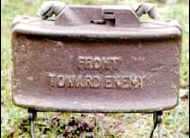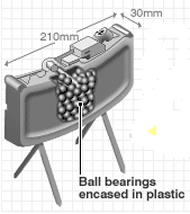Honorary negro
Dwight hunched against the side of the chopper from which Willy’s Rome Plow swung like a pendulum over the pocked mountains. He squats like a VC prisoner thought Willy, so doomed he doesn’t care. Willy had ordered Dwight (though technically a civilian) not to fly with him to the new firebase, but Dwight had grown more stubborn the longer he was dead. The base was under construction near the headquarters of the 1st Cav’s 3rd Brigade. That’s General Custer’s old 7th Cavalry, someone told Willy. He said it pokerfaced and waited for Willy to react. Willy didn’t know how.
The Chinook descended, hung over a knoll of tall grass and low trees — Willy had expected to see dust and activity — and lowered the Plow. Someone below unhooked it; the cable rolled in, the chopper slid to one side, touched ground long enough for Willy and Dwight to climb down and a stream of supplies and sandbags to be kicked off, then skidded back to the sky where it belonged.
“Welcome to Fire Base Mona,” said one of the 20 GI’s standing around, most of them Black.
“You’re kidding,” said Willy. That’s it. There’s a limit. Call it off. Got no use for this.
“Base commander’s wife or some shit. I’m Lake.”
“Wilson Pickett.”
Beat.
“I know,” said Willy. “For real. I mean it.”
“That’s cool. Can you sing?”
“No.”
“Hey, guys!”
The platoon gathered.
“This here’s Wilson Pickett.”
Beat.
“For real.”
Beat.
“I mean not for real Wilson Pickett, for real his name.”
“How bout we make him an honorary Negro?” someone suggested.
A chuckle of general consent. There was a joke inside the joke, Willy sensed, some real-life, serious decision-event-joke of which he could not be aware.
“Where’s the firebase?” he asked.
“You’re standing on it, honorary nigrah. We got to make it real before Charlie figures us out. Crank up that Plow.”
Which meant setting the Clearing Blade with a bar inserted in a hole in the brace tube so the left end rested about an inch lower than the right, and tilted back slightly to skim the ground without digging, thus preserving the root structure of the decapitated vegetation to prevent soil erosion. Willy employed the Outcrop Method, beginning where the chopper had laid the Plow down, cutting outward in concentric spiralling clockwise circles, producing a central windrow of inward-falling tree trunks, limbs, grass, and bushes. Later that morning another Plow was landed, whose operator pushed the windrow material down the gentle slope to reinforce the bunker line 40 yards out. A grunt from Alabama had taught the platoon old chain-gang songs, which they enhanced with a Motown backbeat and sang while enlarging the trenches they had dug far inside the future perimeter just in case Charles did learn what they were up to and intended to return the area to its aboriginal condition.
By nightfall they had cleared an area the size of a round football field with perimeter stakes every 15° to mark the 24 bunkers-to-be. Beyond, at 70 yards, a ring of cleared ground held a row of triple concertina wire that encompassed the base, the low grass inside the wire salted with 100 Claymore mines pointed outward toward the enemy, who, as far as the men of Firebase Mona were concerned, comprised the entire Asian population from China to the Mekong Delta, Laos to the South China Sea.
At dusk, they gathered inside the mini-base of hand-dug trenches at the center of Why “Firebase Mona,” why, why, why? The men insisted that Willy and the other engineer — a white guy whose name everyone forgot, driven from their minds by Willy’s — park their Plows at a distance “so if they gets hit by mortar fire they don’t blow up on us.”
Last year, Lake was stationed at a cushy California missile base. There had been a red alert. “That means war. It don’t mean nothing but war. Only war,” which turned out to be a control center error, but no one knew it at the time, including the base commander, non-coms, and chief warrant officer, who jumped in their cars and split. “They told me not to open my fuckin mouth, but I did, so I’m here.”
“Wha iz da hurhus a dis hirehase?” asked Dwight.
“What’s this firebase for?” Willy passed along. Only he could hear Dwight’s lipless speech.
“It’s called a firebase on account of it is meant to be fired at. Theory is, the enemy will find us an attractive target for one of their famous carefully-planned night attacks. You see that grove past the wire?”
“No.”
“Perfect for enemy concealment. The brass leave it in hope that the enemy will conceal themselves there, allowing us to obliterate them.”
“You’re suhhosed to sit here and get shot at?” said Dwight. Willy repeated the question.
“Dumb-ass, if they don’t shoot at us how do we know where they are?”
Lake must have seen Willy’s expression in the cigarette gleam. Dwight gave off an undefineable glow, like marsh gas.
“Being an honorary Negro, you deserve an explanation. We are here to be killed. Charlie wants to kill us. America wants to kill us. America has a philosophy: kill the niggers. Keep em off the streets. Send em to Vietnam. Charlie has a philosophy: every inch of this is his, every grain of rice, every blade of grass. Us, we’re just walking and looking, walking and looking. So I have a philosophy: get me out of here alive. To actuate my philosophy I have to lay down unending fire, blow em away, mad minute, mad hour, mad day, mad month till I’m outa here. And that is what this nice kid from Detroit who should be home practicing the oboe has become. Pisses me off.”
“What’s that got to do with getting them to shoot at us?” It occurred to Willy that the firebase was laid out like a target in concentric circles separated by bands of concertina wire, sandbags, trenches, bunkers.
“Better here where we can see them, than the jungle where we can’t. Right by me.”
Did he mean right by me, as in I approve, or right by me as in I don’t get it?
The next morning at 0600 a fleet of helicopters dropped a package at each of the twenty-four 15° markers, containing one 15 lb. shaped demolition charge, two sheets of pierced steel planking, and a bundle of sandbags. The men placed the charges next to each stake and blew themselves 24 bunkers, the number considered ideal for a rifle company. Instant bunkers! Just add explosives and serve! Willy, digging holes for command and control bunkers inside the perimeter, was impressed. Around noon, a Chinook delivered a fully assembled, 24-foot observation tower, complete with Army Captain Pete “Tinker” Bell, and a small inflatable hospital unit, which when blown to full size by diesel airpump looked like a bloated Macy’s Thanksgiving Day Parade balloon full of gleaming U.S. medical tools, chests, trays, and tables.
By noon it was complete. Willy stood atop his cab and admired their work. It reminded him of a pop-up book he had in another world, a Wild West town that opened into an instant saloon with balcony, sheriff’s office, bank, jail, doctor’s office, and people in the streets: cowboys, housewives in trailing dresses, children with hoops, Indians, frockcoated top-hatted businessmen, dogs. The general store was torn when he got it.
With Capt. Bell arrived loads of target aquisition devices including aerial delivered seismic intrusion detectors, an AN/PPS-4 radar with a 1.5 kilometer range for personnel detection, xenon searchlights, infrared searchlights and the new starlight scopes which intensified available light rather than emitting a light source of their own. The starlight scope was kept in the observation tower, along with the electronic controls for the outward-radiating bands of Claymore mines, which could be set off by sector at any sign of gooks on the wire.
It all seemed quintessentially (another spelling bee word) American to Willy. What other country on the face of the earth? Maybe Germany and Japan, but they weren’t allowed to play with guns after all the harm they’d done, and Japan made transistor radios with antennas that broke and tiny pink umbrella party favor thingies.
A note about the Claymore Mine, the major staple of Vietnam: It weighed 3.5 pounds and had a kill volume the height of a man out to 50 meters. Most importantly, it was directional. On the gently curved face were embossed the words:

The backside did not display REAR/TOWARD FRIENDS, which has a rude tone and in the dualistic world of war would be redundant and implied, as darkness implies light. Nor did it say SIDE/TOWARD NEUTRALS. It divided the world cleanly, Manichaeanly, into zones of Truth and Error. Manichaeanism, which gave Christianity a run for its money in the early centuries, had a social structure built on concentric circles, an inner circle of the Elect (officers, non-coms, warrant officers), an outer circle of Hearers (seismic intrusion detectors) and Soldiers, and beyond them, the Sinners (Charlie), doomed to remain in the grip of Darkness. Mani’s writings made no mention of civilians, passersby, or neutrals. So neatly did the schema fit the firebase, one marvels that major incidents of heresy did not break out among the troops, which was all for the best, considering how alike the fate of the Cathari (a medieval Manichaeist sect) was to the fate of those caught in a Claymore blast, the shredding of their dark, evil meat and their separation from this vale of sin, the world.
In the Manichaean mythos, the bad guys got first crack: when Darkness perceived the Light it was carried away with envy, greed, and hate, and called on its minions, the Archons, to attack.
As in scripture, so in the world.
 Firebase Mona
Firebase Mona